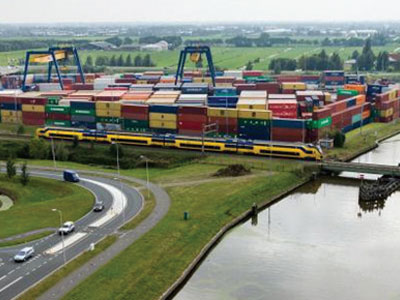Heineken, the Dutch beer maker, has been a pioneer in transporting containers by water rather than by truck to the Port of Rotterdam.
Heineken trucks its beer exports by container to the inland Alpherium container terminal 13 kilometers away from the Heineken brewery. There, the containers are stacked and loaded then loaded again onto inland waterway vessels that sail by river to the container terminals at the Port of Rotterdam, which is 85 kilometers away.

Heineken and a growing number of shipper’s export and import their containers from the terminal.
Smits said more European and Dutch shippers are transporting import and export containers by water rather than by truck because “the congestion on the roads is getting worse and because there is a shortage of qualified drivers.”
He said the problem of hiring qualified drivers is getting worse because younger people do not want to go into the truck driving business.
Smits says that 26 workers operating in two shifts load and unload 100,000 forty-foot unit’s containers per year at Alpherium using two container cranes.
This is the equivalent of 200,000 twenty-foot unit containers per year.
Smits says, “we have the capacity to handle more containers…as many as 320,000 TEUS.”
The terminal operator projects that “with our Alpherium Inland Terminal, we save 6 million Heineken truck kilometers each year! This results in a CO2 reduction of 30%.”
The Netherlands is leading the way in moving more trucks off roads and on to inland waterway and short sea ships to reduce road congestion and truck emissions. This reduces delays waiting for containers to be loaded and unloaded off ocean carriers at main ports, transported through container stacks for pick up or delivery by truck. By loading containers from the ocean carrier to the inland waterway vessel, containers move quickly to and from main ports to smaller regional container terminals.
This system allows for faster pick-ups and deliveries to nearby distribution centers and manufacturing facilities such as Heineken’s brewery.




